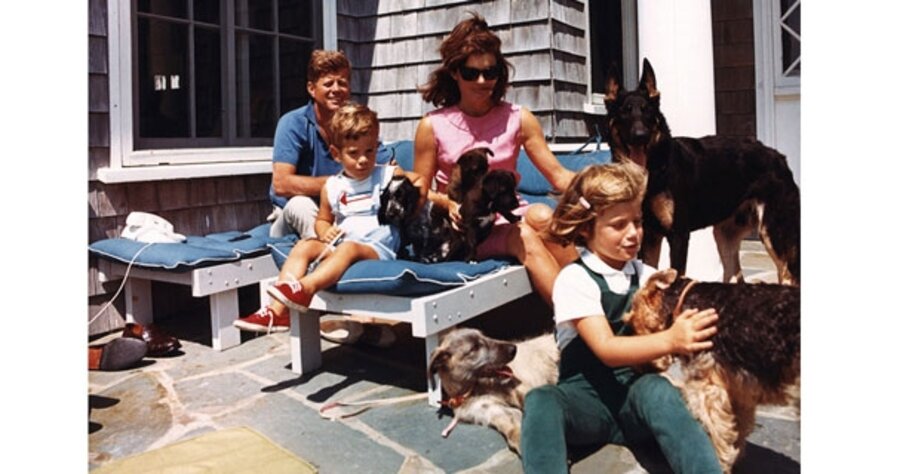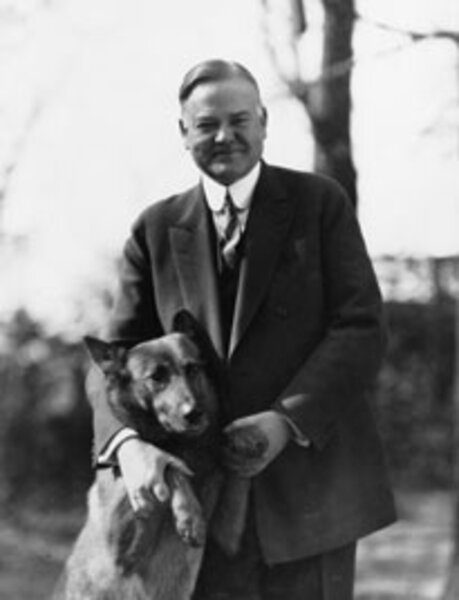An Obama dog: for the kids ... and the country
Loading...
| Washington
Probably, Barack Obama really wants a dog. Daughters Malia, 10, and Sasha, 7, now are old enough to bond with a canine companion.
And the president-elect must suspect his new job is so tough that some days he’ll come home, slump in a chair, and see in a slobbering pet not just his only friend, but a possible Cabinet appointment.
But let’s be honest: presidential dogs can be useful political symbols. They’ve served past occupants of the Oval Office as distractions for the press, image enhancers, and even tools of foreign policy.
Take King Tut, campaign consultant. A large Belgian police dog, King Tut helped Herber Hoover win the 1928 election. An iconic campaign photo depicted a smiling Hoover holding up family pet Tut by his front paws. Handed out to voters by the thousands, the picture softened Hoover’s dour image.
Then there was the famous Murray the Outlaw of Falahill. Fala – that was his nickname – served Franklin D. Roosevelt as a virtual chief of staff. He traveled the world with FDR to wartime conferences, at times entertaining other leaders by curling his lip into a doggie version of a smile, on command.
Pushinka was a Cold War emissary. Soviet leader Nikita Khrushchev presented her to John F. Kennedy’s family in 1961. The daughter of Soviet space dogs, Pushinka reportedly underwent a thorough inspection by American intelligence before she was allowed on White House grounds.
Pushinka and JFK’s Welsh Terrier, Charlie, had four puppies. Or “pupniks”, as the press referred to them. If relations between the US and USSR had followed a similar path, the Cuban missile crisis might have been avoided.
King Timahoe, Nixon administration malcontent, stands as a reminder that not all White House dog choices are successful. A gift from staffers, Tim was an Irish setter, named for Nixon’s ancestral Irish hometown.
Richard Nixon and a high-strung canine purebred weren’t a great match. “Had Tim in the office, both of them pretty nervous,” wrote chief of staff H.R. Haldeman in his diary entry for Jan. 20, 1969.
One recurring problem was that the dog would not cozy up to the president for the requisite photo of world leader plus faithful companion.
“Had Tim in the office, can’t get him to come over by P’s desk, he’s trying dog biscuits, no use,” wrote Mr. Haldeman, in seeming despair, on Jan. 31.
Acceptance of the situation set in quickly, followed by sloppiness.
“Got to tossing dog biscuits around the office for Tim. One hit the grandfather clock,” Haldeman wrote on Feb. 5.
Timahoe eventually settled into his role, though he was prone to racing around whichever hapless White House aide was holding his leash, wrapping them up like mummies.
Not all White House dogs are just props, of course. Sometimes they serve as genuine members of the first family. Sometimes, maybe more than that.
At the height of the Cuban missile crisis, in 1962, JFK summoned Charlie to the chaotic Oval Office, according to then-White House kennel keeper Traphes Bryant.
Soviet ships were steaming towards Cuba. The US Navy was readying to stop them. War seemed close at hand.
JFK petted Charlie for some time. He seemed to relax. Then the president handed the dog back to the kennel keeper, and said, “I suppose it’s time to make some decisions,” wrote Bryant later.
Those decisions eventually helped deescalate the situation, as the superpowers stepped back from what would later stand as their closest, and most dangerous, nuclear confrontation.






